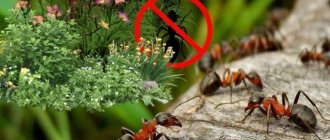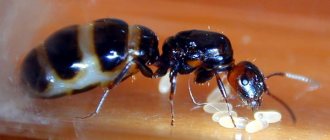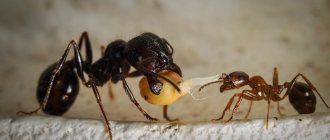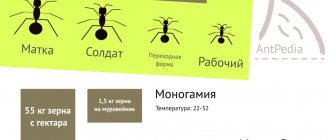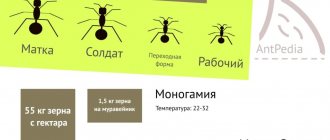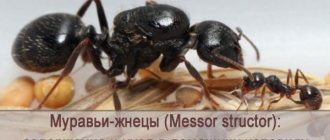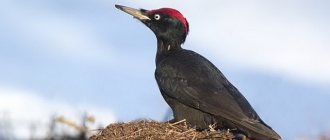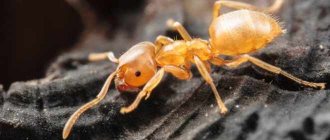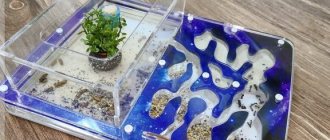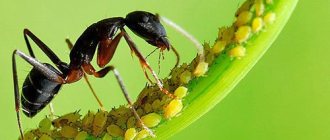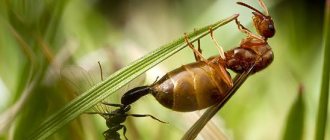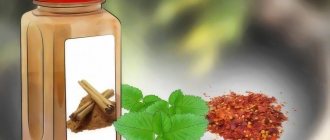The relationship between humans and domestic animals has centuries-old traditions. The most popular pets today are, of course, charming, loyal dogs and charming, independent cats. But what if you are thinking about a pet, but there is not enough time for communication and care. Consider the funny, interesting, unusual, and most importantly, unpretentious ants living in home ant farms.
These intelligent kids have long surprised people with their abilities and high social organization of ant colonies. And observing and caring for ants has become so easy with the advent of formicaria - ant farms. All that remains is to decide: what are the differences and how to choose ants for the farm?
More than 11 thousand species of ants are found in nature. They build their colonies in hot deserts and cold taiga. Some collect nectar and plant seeds, others prefer to hunt. To understand which ants are suitable for formicaria, it is important to know that the microclimate, living conditions and nutrition are individual for each species.
Ant food
Many species of ants require live food in their diet. For example, some even hunt butterflies, others breed aphids for their sweet syrup from flowers, buds, trees, etc.
Other farm ants eat exclusively cereal crops. This is also why they got the name harvester ants.
When dealing with other species, you will have to raise other types of crops or insects, such as mealworms, pupae, etc. And all this is just to feed the ants. Naturally, this is not suitable for everyone and the majority, especially amateurs, prefer to breed reapers, as they are the most unpretentious in terms of feeding.
Lasius
Ants of the genus Lasius are familiar to all of us because they are most often found in parks, gardens and in the city.
Finding the queen of these ants during flight (June-July) is not difficult. Lasius queens are distinguished by a thick abdomen, in which food reserves are stored, carefully provided in the anthill (the queens are intensively fed before flight), so they can establish a colony on their own. The female meets the male in the air, mates, sheds her wings (and the poor male) and digs a relatively shallow burrow in the ground where she begins laying eggs. The eggs hatch into larvae, fed by the secretions of the salivary glands of the uterus (the body's resources are used to create nutrients - fat in the abdomen and muscles of the wings). The larvae grow, pupate, and the first small ants emerge from the cocoons, ready to come to the surface, get food and help with housework. Events at home are developing in exactly the same way, with the only difference that instead of an underground burrow, the queen will live in an incubator test tube. We put the female lasius there, give her a drop of syrup and put her in a dark, quiet and calm place. Then the initial colony develops on its own, and our task is to notice when the worker ants appear so that we can start feeding them with syrup and insects. The lasius colony grows quickly and does not require any special conditions.
Formicarium - any kind, except wood.
Feeding : honey or sugar syrup, live and dead food insects, juicy sweet fruits.
Benefits of Feeding Reaper Ants
Unlike the others, reapers are more convenient and unpretentious in breeding. For proper nutrition, you don’t have to add food to them every two days. In addition, you do not need to breed any livestock, which brings a lot of trouble to many.
Therefore, if you breed Messor Structor ants, then you don’t need to grow anything or anyone else except the insects themselves. At the same time, they are developing well. Just keep in mind that food for harvester ants should consist of several varieties of grains.
Myrmica
Ants of the genus Myrmica live in forests and parks, but can also be found in gardens.
They are painted in various shades of red and brown (from almost black to ruby red), and look impressive in large numbers. Myrmics love moisture (both soil and air) and coolness, and do not feel well in the summer heat. They are active, active and friendly: if one ant has found a source of food, it does not eat itself, but immediately runs to the nest, leaving a pheromone trail behind it. A squad of helpers is formed in the nest, who run after the first ant and help him. Myrmics fly in late summer and autumn, so en masse that the multitude of flying and falling females and males makes it seem as if it is raining. There are winged individuals in the air, and mating takes place on the ground, so the male sometimes has to catch up with his chosen one on foot, simultaneously fighting her off from competitors. Myrmik queens do not have nutritional reserves in their abdomen, so after digging a hole and laying eggs, they go out in search of food once every 2-3 days, collecting flower nectar, parts of dead insects and hunting small arthropods. By the way, myrmics hunt very well, using their sting to kill victims (it also serves for defense).
formicariums need one that holds moisture well, so plaster structures or acrylic ones with gypsum inserts would be preferable.
Feeding : honey or sugar syrup, small live and large dead insects, fruits, pieces of nuts, artificial protein substitutes.
Easy to breed
All ants live according to the principle of a colony, in the hierarchy of which the queen (monogamous) or several queens (polygamous) occupies seniority. Moreover, some colonies can consist of hundreds, thousands and even millions of individuals.
Some species require special conditions, for example:
- increased humidity levels
- truss structure made entirely of wood or plaster
- a certain temperature, etc.
There are other insects that are much easier and simpler to breed, including for children without parental help. Reaper ants are one of these. Regular room temperature is enough for them. To develop at an average speed, you simply do not need to expose them to direct sunlight, drafts and do not put them on the balcony in winter.
Tetramorium caespitum
Small, nosy, dark brown ants that act as orderlies in nature.
Have you ever seen hundreds of these scavengers cutting up a dead earthworm into pieces right on the sidewalk in the city? They probably saw it. You may also have seen Tetramoriums crawl into your sugar bowl or steal food from your cat's bowl, because very often these thieves are found in houses where they live in the foundation or walls. Tetramoriums have adapted to survive in any conditions and reproduce quickly - if only there was food. And a wide variety of food suits them: from dead insects to bread crumbs. The queens of these ants can be found already in early June. They easily raise a colony at home, only to make the work easier, the queen needs to put a dead fly or mosquito in a test tube, as well as a small piece of pumpkin seed (a piece of nut or a drop of syrup will also work). A colony of tetramoriums, with a large amount of protein food, can grow exponentially, but does not require constant expansion of the living space due to the small size of the ants themselves.
formicarium is suitable for them except a wooden one, but it must have an important quality - the absence of cracks (even the smallest!), because tetramoriums are prone to escape. And when they escape, they can harm your other pets and food crops. For the same purposes, the arena must be covered with a lid or treated with an anti-escape agent.
Feeding - honey or sugar syrup, small seeds, pieces of nuts, killed insects, meat, boiled eggs and other natural protein substitutes.
Danger to humans
We all know that many ants bite, especially if disturbed, but this does not apply to all species. Some insects may even try to bite, but they do not have powerful mandibles or a sting to pierce the skin. Their bites can rather be compared to a slight tingling sensation.
Among the most dangerous ants found is a species called Paraponera clavata (Bullet Ant). Despite the serious pain of the bites of such ants, there are still those who undertake to breed them, although for obvious reasons there are very few of them. As a rule, these are top-level experts who have created special conditions with all the necessary safety measures and, of course, reliable farms in every sense.
If we talk about non-dangerous ants, the bite of which is almost imperceptible, these include the reapers. This is also why they are more attractive for breeding.
Cereal types
This group includes the reapers, popular among the Myrmikeepers. They eat mostly carbohydrates and only occasionally protein foods. Their main feature is the ability to make flour, for which they crush the flour and mix it with water. Beginners are advised to keep just such ants, since they can be left for a long time, providing a supply of food.
If you decide to place reapers in the formicarium, then there will be no problems with them. The main thing is to feed the insects and give them water in a timely manner. Such ants carefully monitor their food supplies, filling entire chambers with seeds and organizing their ventilation.
Let's sum it up
If you don’t know where to get ants for your farm and what type to choose, in most cases the ideal option will be reapers and here’s why:
- Pronounced polymorphism (different sizes). Thanks to this, it is much more interesting to observe such ants, because based on their size, they each perform their own tasks.
- Safety for humans and animals. Even the largest soldiers are not able to bite through the skin.
- Calm character.
- Do not cause allergic reactions.
- They do not require live food.
- Easy to breed. The only necessary condition is a humidity gradient (part of the formicarium must be wet and the other dry, so there must be gypsum inserts in the farm).
In addition to all of the above, harvester ants live in the south of Russia, that is, they do not need to be transported from other countries.
If this article has convinced you, and you are ready to buy harvester ants, you can do it right now. We work not only in Moscow, but are also ready to deliver insects, as well as farms of various species, to any place in the country.
What is an ant farm?
An ant farm is a home anthill, which is a container filled with a special gel, sand or other filler. In it you can easily observe everything that happens inside the ant family.
Scientifically, an ant farm is called a “formicarium”. For the Russian market this product is still quite exotic. But gradually formicaria are gaining well-deserved popularity.
An ant colony is like an exotic pet. There are no special problems in its maintenance, and observing the inhabitants of the anthill is a very exciting activity. At the same time, you get the opportunity to see the development of the colony from the very beginning.
Recently, formicariums have begun to be purchased for offices. Some might want to use it on their desk, since farms are compact and don’t take up much space. And someone buys large farms for the hall or for the boss’s office.
Many people give ant farms as an original gift. Ants are social insects, so you can watch them for hours, they are constantly doing something and interacting with each other.
Children will simply love the ant farm! They are interested in what happens inside the anthill and how these insects develop. They have the opportunity to grow a huge family from a small colony of 20–25 ants. The formicarium also allows children to get to know nature better and, at least for a while, take their mind off gadgets. While looking after the ants, they learn a lot about the fascinating world of these insects, which have been living on our planet for several million years. And for adults, such observation is the best way to disconnect from everyday worries for at least an hour and let the body relax.
Inhabitants of the formicarium
There are a huge number of species of ants, completely different from each other. For example, there is such an amazing species as Amazon ants, which rob the anthills of other species and drag away the larvae from there. Subsequently, the captive ants become their slaves and look after the Amazons.
There are leaf-cutter ants that live inside the mycelium, which they grow themselves. Their jaws are very well adapted for cutting leaves into small pieces and carrying them to the mycelium, and then building a dwelling from it, as well as feeding on it.
There are real giants in the world of ants, reaching a length of 4 centimeters.
Ants are mainly divided into hunters and gatherers. Hunters need protein food and carbohydrates; they are predators and hunt insects. It is very interesting to watch how ants use their antennae to chase prey by smell. When one of the ants finds syrup or fruit, on the way back to the anthill, it marks the road with its abdomen, which allows its fellows to quickly find their way to food. All these interesting points will be clearly visible to you in your home farm.
Gatherer ants differ from hunters in the peculiarities of their content. They feed mainly on what they find. Mostly these are plant seeds (poppy, rapeseed, millet). They will also not refuse protein foods. They can eat dead insects or the same boiled chicken (if we talk about a home ant farm). They do not hunt insects, they only defend themselves. But these ants have a very interesting internal structure of the anthill. There are food storage chambers (warehouses where they store seeds for a long time), birth rooms, dining rooms (where they bring seeds, soften them with moisture and eat them), rooms for caring for the young (in these rooms the ants care for and feed the larvae). And all the processes that occur in the formicarium can be observed with your own eyes!
As a rule, insects within the same family are divided into castes: scouts, workers, nurse ants, soldiers and queen. Almost every species has scouts; they make up a small percentage of the total population of the anthill. Their task is to explore unfamiliar territories and look for new food sources. Workers are the main hard workers of the colony; they build, transport food, sort warehouses, and clean the anthill. Soldiers differ from the rest in their larger size, have a large head and powerful jaws. The nannies practically do not leave the young; they feed the larvae and the queen itself.
The queen is the No. 1 person in the colony. All the inhabitants of the anthill are born from the same womb, that is, they are all brothers. The task of the uterus is only to give birth to new ants. She doesn't even get food herself. There are some species in whose colonies several queens can exist.
Each anthill and its inhabitants have their own unique smell, so even ants of the same species, but from different anthills, will be at enmity with each other.
